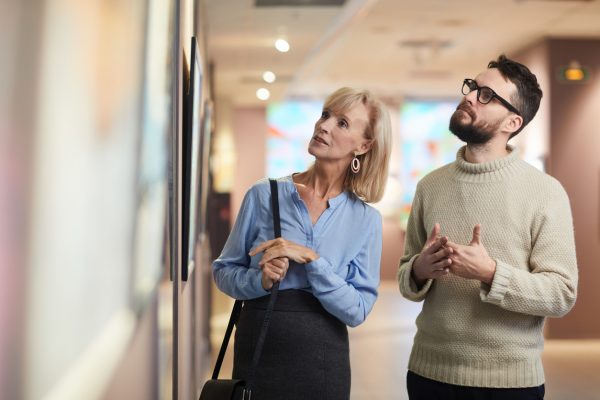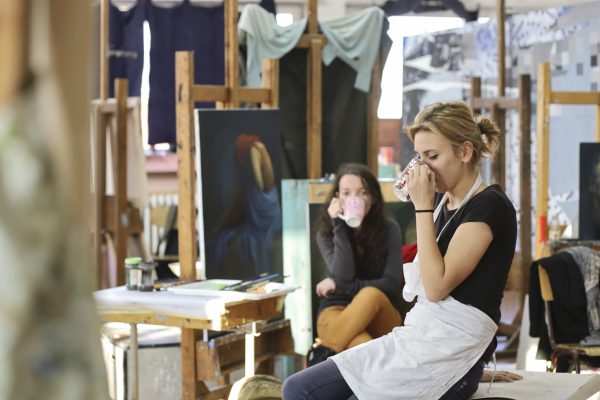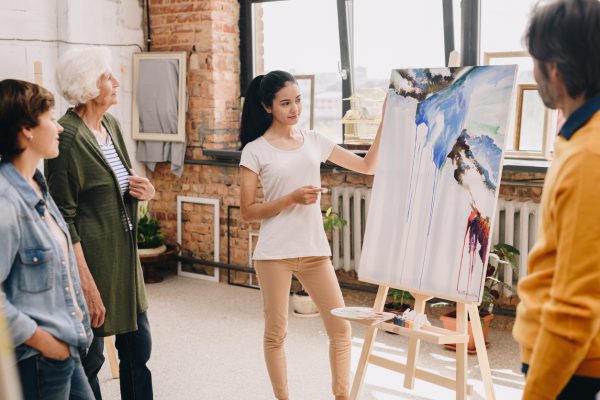We’re all familiar with the ‘starving artist’ archetype: a sombre and solitary figure that hides away, labouring obsessively over their paintings. While this myth persists throughout artist biographies and period dramas, the reality of the artist’s journey today couldn’t be more different. In our globally connected world, success in any profession is often contingent on forging strong relationships with like-minded people, and artists are no exception.

Surrounding yourself with a supportive community of artists can offer you perspective, encouragement and opportunities, but making new friends as an adult isn’t always easy. Getting a job in a creative industry, or being enrolled in art school are sure-fire ways to find yourself embedded within a community of artists, but in the current economy, what if these options are no longer viable? We outline seven alternative strategies to help build long-lasting creative friendships.
Join an artist association
Artist associations are a great way to integrate yourself into a community of similar people and access new opportunities. Each association differs in terms of its focus, size, and demographic, but they all generally function on the basis of annual paid membership. As a member, you will be able to participate in exhibitions, critiques, meetings and other more specialist events such as mentorship programmes. Consider what kind of relationships you want; are you looking for a small local group that meets frequently? Or perhaps you like to travel and prefer to be part of a larger, national group. Whatever your preference, an artist association is a sure way to reap the benefits of community.
Take a class or attend a local workshop

Remember how easy it was to make new friends as a child in school? If you have some time to spare, why not sign-up to a class or workshop? Not only will you meet other practitioners, involving yourself in these activities is a chance to expand your skill set, access feedback and enrich your current practise.
See if your local college or community centre runs any night classes for life-drawing or pottery, you never know, you could be the next Grayson Perry. Alternatively, if you are a graduate, why not try the alumni network of your university or college, they often hold networking events for past students.
Utilise social networks
In an increasingly virtual world, social media can be a vital tool for building your network. Though there is no substitute for face-to-face interaction, platforms like Facebook, Instagram and Twitter can help you identify other artists and creative events in your area. Start by following local artists and engaging with their posts, it will let them know you’re around and give you an insight into their work from which to start a conversation. The events function on Facebook and sites like Meetup are also great places to start searching for gatherings. Remember that online connections should be a supplement for ‘real-life’ interaction, not a substitute for it.
Go to opening nights and studio tours

Show support for your community by attending local events such as private viewings and open studios. It can be intimidating at first, but people will appreciate the effort you make to get to know their work. Don’t be scared to introduce yourself and ask plenty of questions — engaging in authentic conversation is the surest way to build solid, long-lasting relationships. Make it a priority to maintain a presence at these events, after a while you’ll notice the same faces and become much more comfortable. Open studios, in particular, are important opportunities for in-depth conversation with artists, as they tend to be less hectic than opening receptions. The book I Like Your Work: Art and Etiquette by James H Bae has plenty of useful advice on how to navigate the social aspect of these events.
Get a studio in a shared space

When inspiration dries up and opportunities fall through, it helps to have people around you that understand what it’s like, and who can offer guidance based on their similar experiences. Many cities have old warehouses or offices dedicated for use as artist studios. Bagging a studio space in one of these places is one of the most direct ways to immerse yourself among a group of working artists and surround yourself with inspiration. It’s a chance to collaborate with others on new projects, share skills, materials and feedback, whether that be through organised critiques or a casual chat. Often, you’ll find it’s the small conversations during a tea break that can trigger that ‘aha!’ moment that propels your work forward.
Apply for residencies and collaboration opportunities
Always be on the look-out for residency opportunities or group projects. Often, these are national or international opportunities that require travel. When the local scene has become too familiar, residencies offer a chance to develop your ideas in a new environment and meet artists from different cultures. Whilst it’s important to have artist friends in your area, the world is a big place full of interesting people. Forming connections with artists from elsewhere could lead to exciting international possibilities in the future.
Top tip: Learn about residency opportunities and member-submitted events by signing up for the ArtWeb newsletter.
Start your own group

If you’ve exhausted this list to no avail, it’s time to take the reins and start your own group. Perhaps there isn’t a gallery in your town, or it’s difficult to find studio space. Find a venue that will let you use their space, a school or church hall, for example. You could start by running a critique once a month, with each attendee bringing one piece to present. Advertise the event online using social media, ask the local art college to include it in their newsletter. Alternatively, you could arrange a trip to the nearest gallery, or start an artist’s reading group. Be responsive, accessible, and kind to the people you meet and the rest will follow.







